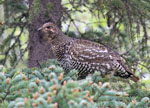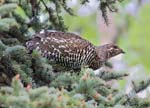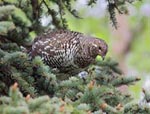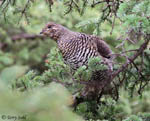Spruce Grouse
Falcipennis canadensis
| Length: 16 inches | Wingspan: 22 inches | Seasonality: Non-resident in South Dakota |
| ID Keys: Males dark overall with black neck and chin, red stripe over eye. Female plainer, brownish overall, dark barring underneath. | ||
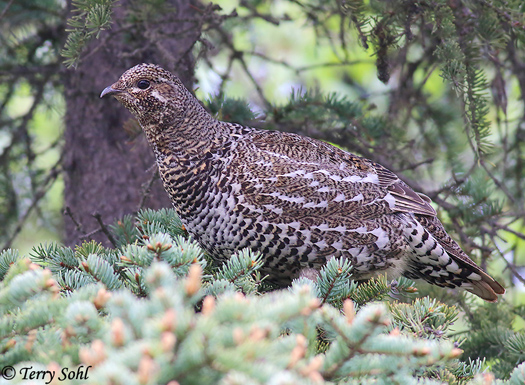 The
Spruce Grouse is a large bird of northern forests, common throughout much of
Canada and Alaska, but typically more scarce in the northern U.S. states in
its range. The species is commonly hunted in the Canadian portion of
its range, but due to lower numbers in many U.S. states, hunting is often
restricted. For birders, Spruce Grouse can be very annoying to search
for. Unlike many birds which flush upon approach, Spruce Grouse often
remain still unless approached extremely closely, and despite the relatively
large size, the camoflague and lack of movement can make them difficult to
spot. Displaying males fan their tails and making deep drumming sounds
with their wings, but even displaying males are typically only heard at
relatively close range. Note that "Franklin's Grouse" was once
considered a different species. The Franklin's Grouse lives in the
southwestern part of its range, and has all black tail feathers. Other
birds in the northern part of the Spruce Grouse's range have a rusty-colored
band of feathers on the tips of the tail.
The
Spruce Grouse is a large bird of northern forests, common throughout much of
Canada and Alaska, but typically more scarce in the northern U.S. states in
its range. The species is commonly hunted in the Canadian portion of
its range, but due to lower numbers in many U.S. states, hunting is often
restricted. For birders, Spruce Grouse can be very annoying to search
for. Unlike many birds which flush upon approach, Spruce Grouse often
remain still unless approached extremely closely, and despite the relatively
large size, the camoflague and lack of movement can make them difficult to
spot. Displaying males fan their tails and making deep drumming sounds
with their wings, but even displaying males are typically only heard at
relatively close range. Note that "Franklin's Grouse" was once
considered a different species. The Franklin's Grouse lives in the
southwestern part of its range, and has all black tail feathers. Other
birds in the northern part of the Spruce Grouse's range have a rusty-colored
band of feathers on the tips of the tail.
Habitat: Well named, Spruce Grouse are indeed often found in spruce forests, but they will also inhabit a variety of ovther conifer forest types. They can often be found in areas of dense undergrowth, and seem to do best in areas with a mix of forest ages, such as in areas with patches that have been disturbed by fire and are in a successional state.
Diet: Most of the diet consists of the needles of conifers, especially in winter months when conifer needles may make up the entire diet. They will also eat other leaves, buds, flowers, fruits, berries, insects, spiders, and snails.
Behavior: During the winter months, most of its foraging for conifer needles is done up in trees. During other seasons, they may feed more often on the ground, as the diet is more varied in those seasons.
Nesting: . Nests are built on the ground under cover of a conifer tree or thick undergrowth. The nest is built by the females, and consists of a shallow depression scraped out of the forest floor and lined with a meagre lining of leaves and conifer needles. Females protect the young upon hatching, but the young are responsible for finding their own food.
Song: Males that are displaying will utter a very low-pitched hooting sound, sometimes given in series.
Migration: Considered permanent residents throughout their range. However, there is some short-distance movement between winter and summer ranges for some birds, but the distance is typically very small (15 miles or less) and doesn't represent a true migration.
Interactive eBird map: Click here to access an interactive eBird map of Spruce Grouse sightings
Similar Species: Most similar in appearance is the Blue Grouse, now split into two species, the Sooty and the Dusky Grouse. Those birds are larger than the Spruce Grouse, and lack the extensive white spotting on the underparts of the bird. Females are similar to the Ruffed Grouse in appearance.
Conservation Status: The IUCN lists Spruce Grouse as a species of "Least Concern". Populations are widespread and common throughout much of the Canada and Alaska portions of its range. However, Spruce Grouse are susceptible to habitat loss, and populations in many U.S. states are listed as threatened or endangered.
Further Information: 1) Cornell's All About Birds - Spruce Grouse
2) Minnesota Department of Natural Resources - Spruce Grouse
3) New York State - Spruce Grouse Fact Sheet
Image Information: May 20th, 2014 - Near Anchorage, Alaska - Terry Sohl
| Click below for a higher-resolution map |
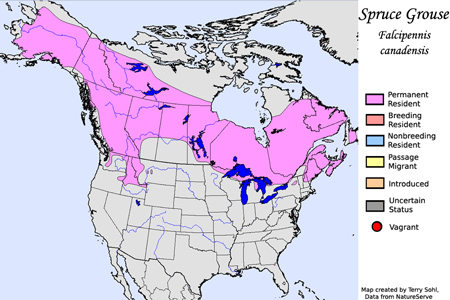 |
| South Dakota Status: Non-resident in South Dakota |
Additional Spruce Grouse Images
